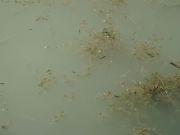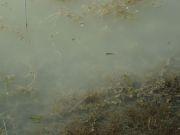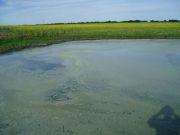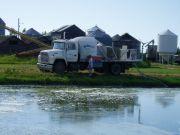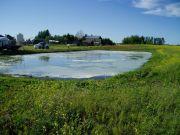For many farms, dugouts are the only source of water for their domestic and livestock needs. Due to the dugouts' susceptibility to contaminants (e.g. algae, silt, nutrients) maintenance is essential.
Traditionally, copper sulphate and Reward treatments have been used to provide short-term control of algae blooms. However, recent studies have shown that the use of hydrated lime is a more complete and longer lasting method of improving dugout water quality.
The benefits of dugout liming include the following:
- reduced algae growth
- reduced growth of submerged rooted plants
- phosphorous removal from the water
- settlement of silt from the water
- a clean and clear dugout
Hydrated lime (calcium hydroxide) is mixed into the dugout water and allowed to settle. The lime acts as a coagulant, which causes the algae, silt and phosphorous to settle to the bottom of the dugout. The settling of the phosphorous will result in less algae growth over the following season because of the reduction in phosphorous required for algae growth. Experience has also shown that the lime treatment will reduce the growth of most rooted water plants, such as Richardson's pondweed.
Caution
• Hydrated lime is extremely corrosive. Safety equipment must be worn to protect skin and eyes from chemical burns. A number of qualified custom applicators are available who have the necessary equipment for water testing, safe handling and application of hydrated lime. The cost of a custom lime treatment ranges from $200 to $500 per dugout.
• Do not treat dugouts stocked with fish. A hydrated lime treatment will kill fish.
• In the short term, some intensive livestock operations such as dairies, poultry barns, piggeries and feedlots may encounter reduced production due to the change in taste of the water.
• Lime treatment temporarily increases the pH level of the water. The pH level will return to normal levels within a few weeks to one month after treatment.
Before applying treatment
Wait until the water temperature is above 15°C (generally between June 1 to October 1). Divert or block off any unwanted water flow into the dugout (e.g. gated culvert). This step will prevent any dirty runoff water from entering the dugout and destroying all the benefits of a lime treatment. Summer rainstorms are extremely destructive because of the huge amount of sediment and nutrients they deposit into the dugout during runoff. Raise the floating water intake line close to the surface of the water. This approach will allow you to take the clear water from near the surface of the dugout.
Applying the Lime
Lime is most often applied by a custom applicator. The hydrated lime is mixed into a wet slurry and sprayed evenly over the entire water surface of the dugout. Concentrate on the deeper areas of the dugout and on any rooted plants along the edge. The hydrated lime must be thoroughly mixed in the dugout water.
Apply one treatment. Wait until the water surface clears (three to seven days) before using the water for any purpose.
Note: Studies have shown that aerating the dugout during the first few days after treatment improves rather than deters the settling of the lime. Wave action created by a windy day will also improve the mixing.
Maintenance
After the application of the lime (or any other treatment), maintenance is essential to sustain good quality dugout water. Here are some guidelines that must be followed to achieve this result:
Keep barnyard and silt-laden runoff out of the dugout. Keep all livestock out of the dugout. Keep all organic matter (e.g. leaves, hay, grass) out of the dugout. Do not spread manure or fertilizer near the dugout. Maintain grassed waterways feeding into the dugout.



